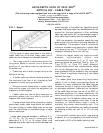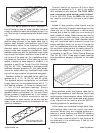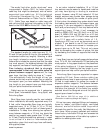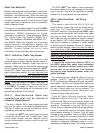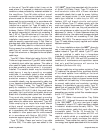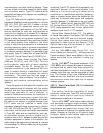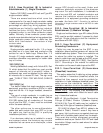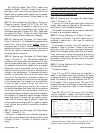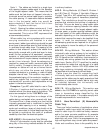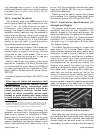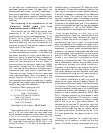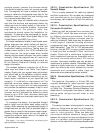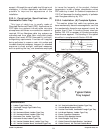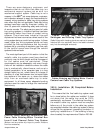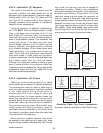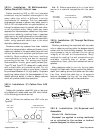
Note 1. The cables are limited to a single layer
with spacing between cables equal to the diameter
of the largest adjacent cable. This means that the
cables must be tied down at frequent intervals in
horizontal as well as vertical cable trays to maintain
the cable spacing. A reasonable distance between
ties in the horizontal cable tray would be
approximately 6 feet
(See Section 392.8 Cable
Installation - Tying cables to cable trays)
.
Note 2. Spacing the cables a minimum of 1 inch
from the side rails to prevent dust buildup is
recommended. This is not an NEC requirement but
a recommended practice.
Where cable tray wiring systems with current
carrying conductors are installed in a dust
environment, ladder type cable trays should be used
since there is less surface area for dust buildup than
in ventilated trough cable trays. The spacing of the
cables in dust areas will prevent the cables from
being totally covered with a solid dust layer. In dusty
areas, the top surfaces of all equipment, raceways,
supports, or cable jacket surfaces where dust layers
can accumulate will require cleanup housekeeping at
certain time intervals. Good housekeeping is
required for personnel health, personnel safety and
facility safety. Excessive amounts of dust on
raceways or cables will act as a thermal barrier
which may not allow the power and lighting
insulated conductors in a raceway or cable to safely
dissipate internal heat. This condition may result in
the accelerated aging of the conductor insulation. A
cable tray system that is properly installed and
maintained will provide a safe dependable wiring
system in dust environments.
Exception: Type MC cable listed for use in Class
II,Division I locations shall be permitted to be
installed without the above spacing limitations. This
was a new exception for the 1999 NEC
®
code.
For this type of wiring there is no danger of the
cables being overheated when covered with dust.
The current flow in these circuits is so low that the
internally generated heat is insufficient to heat the
cables and cable spacing is not a necessity. Even
under such conditions, layers of dust should not be
allowed to accumulate to critical depths as they may
be ignited or explode as the result of problems
caused by other than the electrical system.
502.4(B)(3). Nonincendive Field Wiring
Wiring in nonincendive circuits shall be permitted
using any of the wiring methods suitable for wiring
in ordinary locations.
503.3. Wiring Methods. (A) Class III, Division 1
and (B) Class III, Division 2 (Ignitable Fibers or
Flyings). Type MI or MC cables may be installed in
cable tray in these types of hazardous (classified)
areas. The installations should be made using
practices that minimize the build-up of materials in
the trays. This can be done by using ladder cable
tray with a minimum spacing between the cables
equal to the diameter of the largest adjacent cable.
In some cases, a greater spacing between cables
than that based on the cable diameters might be
desirable depending on the characteristics of the
material that requires the area to be classified. Here
again, it must be emphasized that good
housekeeping practices are required for all types of
wiring systems to insure the safety of the personnel
and the facility.
504.20. Wiring Methods. This section allows
intrinsically safe wiring systems to be installed in
cable trays in hazardous (classified) areas. Section
504.30 specifies the installation requirements for
intrinsically safe wiring systems that are installed in
cable trays. Section 504.70 specifies the sealing
requirements for cables that may be part of a cable
tray wiring system. Section 504.80(B) states that
cable trays containing intrinsically safe wiring must
be identified with permanently affixed labels.
Cable trays are ideal for supporting both
intrinsically safe and nonintrinsically safe cable
systems as the cables may be easily spaced and tied
in position or a standard metallic barrier strip may
be installed between the intrinsically and
nonintrinsically safe circuits.
505.15. Wiring Methods. This section was
added to the 2002 NEC
®
to explicitly permit cable
trays in hazardous areas classified by the
international zone system, if the cables comply with
the cable requirements for zone locations.
392.3. Uses Permitted. (E) Nonmetallic
Cable Tray.
There are limited numbers of applications where
nonmetallic cable trays might be preferred over
metallic cable trays for electrical safety reasons
and/or for some corrosive conditions. An example
of an electrical safety application would be in an
electrolytic cell room. Here, the amperages are very
high and significant stray current paths are present.
Under such conditions, there is the possibility for a
17
Cable Tray Manual Cooper B-Line, Inc



